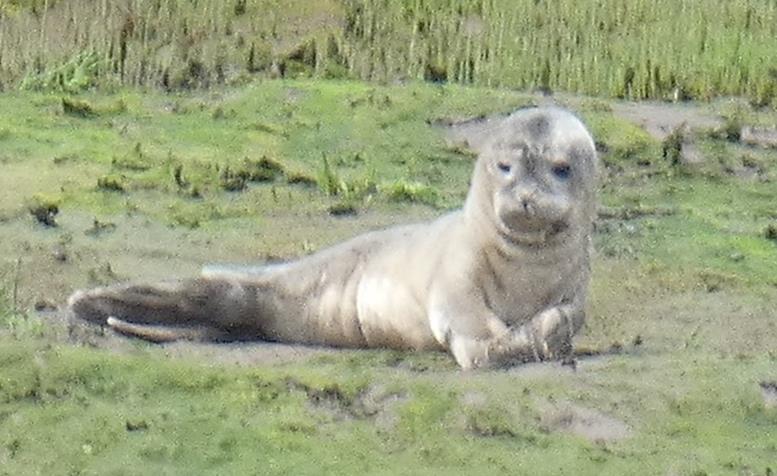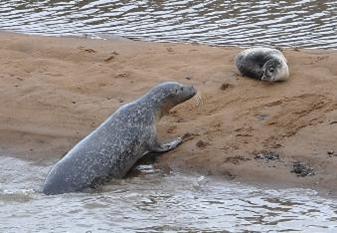Story
I’m raising £3,000 to find out why the seal pups born in the Tees estuary (north-east England) are dying before they are two months old

A young Tees pup – July 2024
I am a retired independent seal biologist, with a lifetime of studying seal pups and their mothers, including pups dying in the Tees estuary 35 years ago – with high levels of the toxic “forever” PCB chemicals in their bodies. I returned to the Tees in the summer of 2024 to lead a small volunteer team (Tees Estuary Seal Study - TESS) to try to find out why so many pups are now dying again - after 30 years of apparent population recovery. To our intense dismay we recorded ~23 pups born in the Tees by mid-July in both 2024 and 2025 - and approximately the same number were reported dying throughout August along the north-east coastline, particularly along the Tees Bay coastline. This seems to be close to 100% death rate of the Tees pups in both years.

A Tees mother and her pup – July 2024
The dying pups stranding on the shore between north Yorkshire and Northumberland are all weighing less than half the normal weight for common (harbour) seal pups around 6 weeks of age – and most of them also suffered from the now infamous “mouth rot” - as in the pup with mouth rot in the photo which weighed only 8 kilos - which is ~3 kilos less than birth weight! The pups usually have swollen muzzles and a grey surface to tthe soft tissue inside the mouth or on the lips, while in some pups the palate bone may be exposed or the tissue rot has spread to the face or to the nasal cavity. These pups were either euthanised by vets or were taken to rehabilitation centres.

Pup with mouth rot
Laboratory culture of our mouth rot samples from five pups in 2024 was able to isolate and identify many of the bacteria, although these were different in each pup, although all pups showed a profuse growth of anaerobic bacteria. Further culture analyses of eight more euthanised pups in August 2025 were funded by Sea Changers (see below); these pups' mouths also all had profuse growths of anaerobic bacteria, as well as of E.coli , suggestive of recent sewage spills. Online research suggested that the seal pups' mouth rot resembles an oral condition in immune compromised humans known as "acute necrotising ulcerative gingivitis" (ANUG), or "NOMA" in its more severe form, when swelling and spreading of the rotted tissue occurs. We now suspect that the reason why the rotting tissue in our seal pups is primarily on the hard palate behind the front teeth - we suspect it may be initiated by the pup suckling from a nipple contaminated by toxic mud on the Seal Sands mudflats where they are lying.
This hypothesis, however, does not explain why the stranded pups are so extemely underweight. Analyses from six pups in 2024 showed that those pups all had toxic levels of PCBs, which are known from many studies to prevent normal infant growth AND to cause immunosuppression. These PCBs come from the mothers’ milk, which the mothers get from eating contaminated fish. PCBs were manufactured in the Tees before they were banned in the 1980s. These forever toxic chemicals can lie in undisturbed sediments for years and can become harmful again if dredged up and recirculated in the ecosystem, where they accumulate in the bodies of fish and then to the pregnant seals, and then in their milk given to their pups;
This past summer (2025) we have also taken blubber samples from the same eight pups euthanised by vets, and will continue the PCB analyses on these samples when the funds are available. These analyses should further test our hypothesis that there is a link between high PCBs, extreme low body weight and severe bacterial mouthrot infections in these young pups.
We also intend to carry out DNA testing of the mud next summer (2026) to see if the microorganisms in the mud match those in the pups' mouths. We are now also applying to funding organisations to fund this. Next summer also we also hope to inititiate, along with the local community in Hartlepool, the setting up of a seal pup hospital to see if any of these pups can be saved with the most appropriate treatment.
The £3,000 target is for the cost of further laboratory analyses, continued monitoring of the Tees seal population during the pupping season, close watch for any pups that appear to be unwell while still at Seal Sands, and now for the setting up of a seal pup hospital in the Hartlepool area next summer, including special high fat milk formula for the pups (this has to be imported from the U.S) as well as travel & accommodation for the volunteer team.
We would like to thank our anonymous donor last year (2024), who paid for the PCB analyses of the first six pups, and Sea Changers, whose grant covered the cost of the pathology analyses for the eight pups in 2025.

For more information go to
https://www.sealresearch.org/research/tess-seal-pup-crowdfunding-project